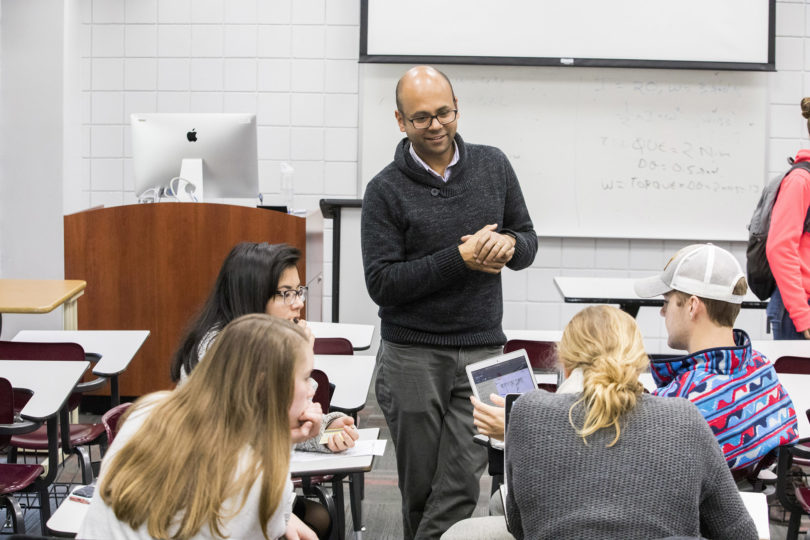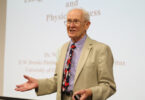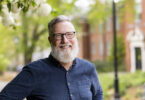Students in active-learning classes at UGA are getting higher grades, spending less time sitting through lectures and getting more feedback from faculty.
It’s all part of the charge to transform courses to actively engage students, and specifically the result of the Center for Teaching and Learning’s Active Learning Summer Institute. Last summer, faculty members participated in the multi-week intensive program to transform courses to include more active learning. They learned how to select interactive classroom and assessment strategies, design learning experiences that are appropriate for the content and level of the students, and even how to evaluate and fine tune their course by collecting data on the impact of their course redesigns.
Redesigning courses
The 32 faculty members who participated in last summer’s inaugural institute taught a total of 8,643 students this year. And the process started with redesigning their courses from the ground up.
“We want the faculty to really think about the intentional design of their course, and whether they are designing classroom experiences that cultivate the discipline-specific skills, knowledge and habits of mind they want to foster in their students,” said Megan Mittelstadt, director of UGA’s Center for Teaching and Learning.
For an engineering professor, instead of explaining a principle and then demonstrating solving an engineering problem for the class, the professor might pose a question to the class, have the students attempt to solve the problem themselves, then discuss the answer with a peer, and then the professor shows how the problem should be solved and why. “The idea behind active learning is that if you make learning experiences desirably difficult for students, the learning is deeper and more durable,” Mittelstadt said. “It’s more than injecting activities into the classroom. It’s thinking about how to reach all of the students and engage as many of the students as possible at any given moment.”
The impact
After the course redesigns, data from fall semester classes shows there are more discussions on why course material is useful, more opportunities for students to receive feedback on their work before earning a grade, and more faculty using pre-class assignments to make sure students come to class prepared to engage more deeply with the material.
For example, Toyin Alli, a lecturer in mathematics, flipped her Precalculus class after participating in the Active Learning Summer Institute.
Instead of lecturing in class, she created video lectures for her students to watch and take notes from before each class—as well as a pre-class assignment to complete. In class, students will work on practice problems while Alli walks around to answer questions and help.
“When I taught the class previously, I noticed that my students could follow along and understand in class. But when they worked problems on their own, for homework, they would get stuck,” she said. “With my flipped model, I could observe my students practicing problems and they could ask me, or their peers, questions, in real time, whenever they got stuck. And when I noticed misconceptions, I could share them with the class.”
According to UGA students, Precalculus, Math 1113, is one of the most difficult classes to master. After flipping her class, all of Alli’s students passed with a C or higher. “And they seemed to enjoy the course much more,” she said.
And she’s not alone. Many instructors are seeing improvements in course evaluations, according to Colleen Kuusinen, assistant director for the scholarship of teaching and learning. Instructors are also seeing improved student performance on exam questions from pre-Active Learning Institute to post-Active Learning Institute, with some faculty seeing reductions in DFW rates in courses that had high rates.
Following the data
Part of the institute’s strategy is in collecting data to demonstrate the impact of the course redesigns on teaching practices and student learning—surveys to the students and professors about how much time is spent in lecture, the teaching methods used in class, comparing grades to previous courses, and using consistent measurement of learning between course sections. “During the institute, we prepared the faculty to be patient in waiting for evidence of improved student learning as a result of their course redesigns, as we know it can take multiple semesters for redesigned courses to hit their stride. But this year’s data shows the Active Learning Summer Institute has made a greater positive impact than we expected to see this soon,” said Mittelstadt.
More interest
Faculty interest in active learning is also up. There were nearly 70 applications for the 2018 summer institute, and more than 100 applications for the 2019 institute. And while much of the interest in the first session was from STEM disciplines, interest is broader for the 2019 session with applicants from the arts and humanities, social sciences, social work and forestry.
This summer another 24 faculty members from across campus will go through the program, which will have a three-week intensive in-residence format — after which faculty members will work remotely on their course redesigns to prepare them for the upcoming academic year. Another 6,700 students are expected to benefit from the class changes, as many of the faculty in the 2018 and 2019 sessions teach upward of 200 students — either in large intro classes or many sections of smaller classes.
Not only are faculty redesigning their courses though this institute, they are returning to their departments as champions of active learning. Faculty members from last year’s cohort are expanding the reach of this institute by teaching their colleagues about active learning—giving presentations and sharing the curricula they developed, bringing Center for Teaching and Learning workshops to their departments, and co-teaching classes with colleagues who have not yet gone through the Active Learning Summer Institute. They are sharing the knowledge they’ve learned.
“We see them redesigning other classes that they teach, promoting the adoption of their redesigned curriculum across multiple sections of the same course, and working alongside colleagues to support culture change in their departments,” said Mittelstadt. And the support from the Center for Teaching and Learning doesn’t end at the conclusion of the institute, or even at the conclusion of the summer. “Our job now becomes helping these faculty maintain their momentum by providing sustained support and facilitating communities of faculty who can coach and mentor one another as they implement effective teaching practices.”







